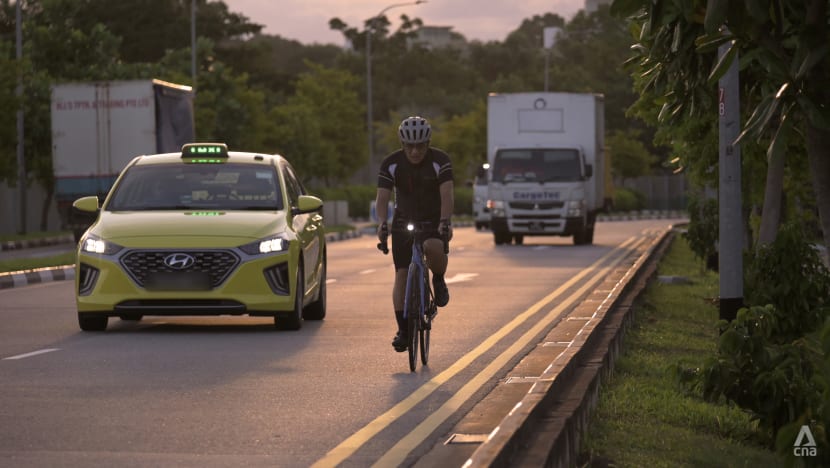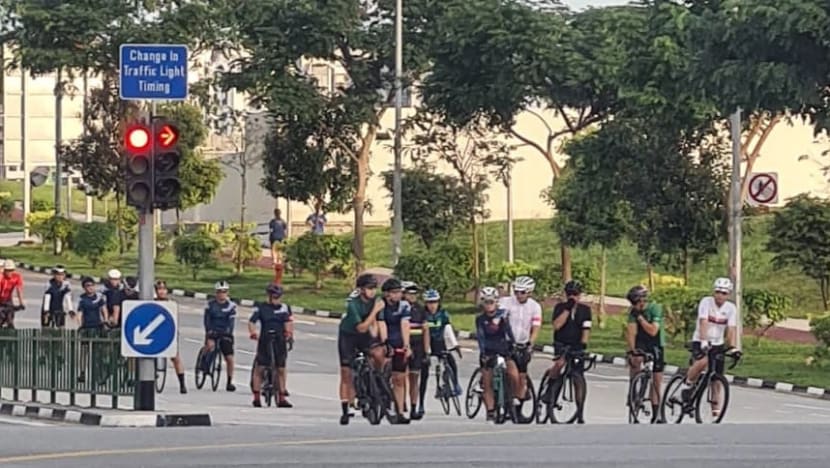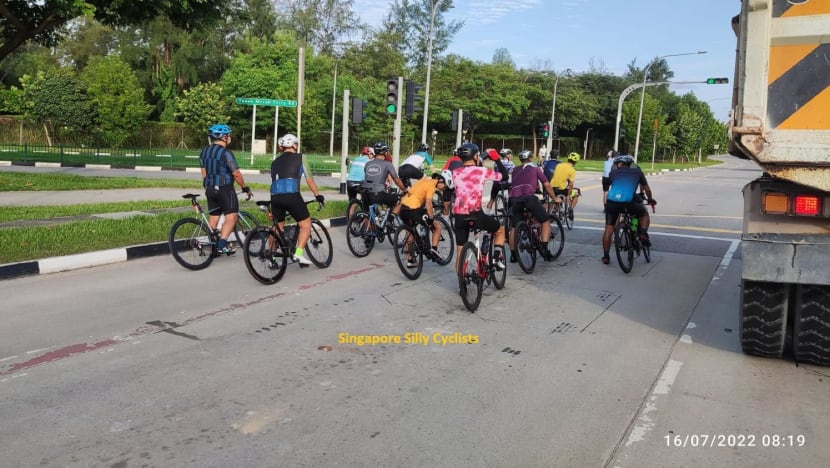'Not practical': Road cyclists on '5 per group' rule a year after implementation
On Jan 1, 2022, a rule was implemented requiring road cyclists to keep to groups of no more than five bicycles in length. Avid cyclists speak to CNA about what has changed and what more needs to be done to enhance cycling culture in Singapore.

A cyclist on the road on Sep 16, 2021. (File photo: CNA/Gaya Chandramohan)
SINGAPORE: Like many others in Singapore, Mr Michael Goh turned to cycling during the “circuit breaker” period in 2020 to stave off boredom.
The 44-year-old was part of the cycling boom during the COVID-19 pandemic – a trend that was soon followed by a spike in the number of traffic accidents involving bicycles.
Amid the growing popularity of cycling, a new rule kicked in from Jan 1 last year to enhance the safety of both motorists and cyclists, by stipulating that those cycling on roads had to keep to groups of no more than five bicycles in length.
On roads with two or more lanes, cyclists are allowed to cycle two abreast, capping such a group to 10 riders. On single-lane roads and in bus lanes during bus lane operating hours, cyclists would have to continue riding in single file, which caps such a group at five riders.
This is due to “space constraints” on Singapore's urban road network, the Ministry of Transport had said then.
Those found violating the rule would face a fine of S$150.
One year on, cyclists who spoke to CNA were mostly supportive of the intention behind the rule but highlighted practical concerns in implementation.
“NOT EVEN PRACTICAL"
Mr Goh, who is also a motorist, said his main gripe was “the rationale behind the five or 10 number” in group size restrictions.
“The intent of this rule is so cyclists don’t hog up the lanes and allow cars who are turning to have a gap to be able to cut in. On paper, that sounds like a brilliant idea to reach a middle ground between cyclists and motorists – but in real life, it’s a disaster,” he said.
Explaining his perspective, Mr Goh painted two scenarios that would likely occur when faced with a hundred cyclists at once on a popular road.
“One, if we maintain the five- or 10-cyclist per group rule (depending on how many lanes on the road) and leave a gap of two (lamp posts between groups), the stretch of cyclists would be about a kilometre long when we stop at traffic lights. Maybe it’s an exaggeration but you get my drift.
“This will actually frustrate the motorists more. It doesn’t allow the rule to achieve what it is intended to do, which is allow more convenience to motorists,” he said.
“Second, how can we prevent other groups or other cyclists from merging into the original group of five or 10? It’s not even practical to be implemented.”
The latter concern was echoed by Mr David Ho, who runs the local cycling Facebook group, West Coast Riders.
“Another common concern is the practicality of switching from 2 x 5 to 1 x 5 and back, when roads go from multi-lane to single-lane and back to multi-lane,” added the 52-year-old over text message in December, referring to the group size limits on different roads.
“Coming close to a year, I’ve witnessed many instances where cyclists don’t bother with adhering to the rule.”
SAFETY IN NUMBERS?
When errant cyclists flout the law, it’s not uncommon for their actions to be broadcast on community pages dedicated to Singapore’s road safety, such as on ROADS.sg and Beh Chia Lor.
A photo on ROADS.sg’s Facebook page dated Feb 13, 2022, showed at least 17 cyclists scattered haphazardly across an empty road.
Another photo on Facebook page Singapore Silly Cyclists dated Jul 16, 2022, showed a group of at least 15 cyclists gathered at a traffic light junction in one large group.
The photos drew the ire of commenters.


Such social media interactions mirror the familiar tussle between cyclist and motorist on the roads, not least since cycling has grown in popularity.
“On one hand, I can see that many motorists have become more understanding since it’s likely they know someone who cycles too,” noted Mr He Ruiming, a 33-year-old avid cyclist who has been cycling to work since 2016.
“On the other hand, it means there’s a whole bunch of new people on the roads that are not always familiar with the rules, or act in ways that are puzzling to other road users. I imagine this to be very frustrating to motorists.”
Even though Mr He rarely does group rides, he suggested that “most cyclists who do dislike the rule (believe) there’s an argument for safety in numbers”.
But Mr Ho from West Coast Riders, who is known for organising group rides pre-pandemic, said most cyclists are now used to riding in smaller packs during the two years of COVID-19 group size restrictions. Some prefer smaller group sizes too.
Mr Goh, who joined West Coast Riders after picking up road cycling during the pandemic, agreed that safety isn’t compromised.
“Actually, having too big a group when cycling is pretty dangerous as well if we are riding at a fast pace. Because if one rider falls, the chances of bringing down another rider are pretty high,” he said.
To ensure the cyclists in West Coast Riders stay safe, they are reminded before “every single ride” about the new rules, said Mr Ho.
“My biggest pain points about fellow cyclists are ignorance about cycling road rules and blatant flouting of traffic laws."
LOOKING OUT FOR ONE’S SAFETY
Despite the rule’s intended purpose of keeping cyclists safe, individual cyclists must also look out for their own safety, they told CNA.
“From a safety aspect, I will usually try to ride in groups if on busy roads. If I am riding alone, I will usually choose the quieter roads or try not to cycle during peak periods,” said Mr Goh.
“Also, I will try to be as visible as possible on the roads with proper lights as well as cycling cameras to report errant drivers or to report bad road conditions, like potholes, to the authorities.”
Mr He, whose main purpose of cycling is “to get to (work) safely while being reasonably fast”, said he tries to ride to work during off-peak hours.
“If there’s a park connector, not-so-busy road or footpath available, I’ll use it – after considering the balance between speed, safety and convenience. And I don’t ride at speeds which will make it hard to react to sudden things happening, such as kids running on the park connectors,” he added.
“And I always assume drivers don’t see me at whatever crossing. I will make eye contact before crossing.”
EDUCATION, NOT REGULATION
Ultimately, to make cycling a feasible mode of transport in Singapore, cyclists said education is key.
Incorporating the cycling culture into the curriculum will “eventually change the mindset that cyclists have equal rights to use the road as any other motorists”, creating “awareness, social etiquette, tolerance and ultimately, safety for cycling as a mode of transport”, said Mr Ho.
“The way around this is not regulations, but education," added Mr Goh.
"I remember we used to have road safety programmes; these programmes should be upgraded to include road cycling safety, not just from a motorist angle but also how to cycle safely on the roads.
"There should also be more education in driving tests, and theory and practical sessions, about road cycling from the perspectives of both cyclists and motorists.”
Cycling groups can also play their part by “providing proper road cycling orientation” to newcomers to “train them on the correct behaviour on the road”, he said.
Mr He proposed several tangible measures, such as building better bike parking facilities.
“Bike parking facilities are still very much an afterthought in many private buildings, especially older ones, and offer bike commuters neither peace of mind nor convenience. Many of them are hard to access, hard to find, and you worry about leaving your bike there,” he said.
“There are many places to lock bikes in Singapore, but most are used as a second storeroom for unwanted bicycles. Freeing these up will help with peace of mind when cycling to work so the people who need them can actually use them.”
Signage on park connectors should also indicate their general direction, he suggested.
“Signs that say ‘this direction to CBD’ or ‘this direction to Jurong’ would help. It’s currently very daunting for a beginner to cycle to work. Cycling paths that run parallel to major roads will also help increase connectivity,” he said.
Even though cycling as a main mode of transport can sound “a bit hardcore and unconventional” by Singaporean standards, Mr He, who is also co-founder of personal finance site The Woke Salaryman, believes people “just need some creativity and preparedness”.
“With a little route planning involved, flexibility, common sense, you’d be surprised by how viable and safe it can be. I won't go as far as to say it’s for everyone, but for many people, there are immense health benefits and financial savings to be made,” he said.
While he isn’t too fussed about "sweaty complaints" caused by Singapore's humidity, he noted that companies can help to alleviate such concerns.
“You know how some people jog, go to the gym, do yoga or spin (classes) before work, and then shower before going into work? It’s the same thing,” he reasoned.
“However, I think there needs to be greater buy-in among employers. Simple things like a small shower in the office, more relaxed dress codes and staggered working hours will all go a long way. From my chats with others, it seems like we’re still a long way from that.”



















